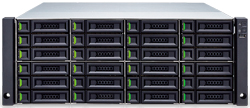RAID LEVELS
RAID LEVEL 2: | JetStor RAID 2 Storage Devices
Each bit of data word is written to a data disk drive (4 in this example: 0 to 3). Each data word has its Hamming Code ECC word recorded on the ECC disks. On Read, the ECC code verifies correct data or corrects single disk errors.

Characteristics & Advantages
- "On the fly" data error correction
- Extremely high data transfer rates possible
- The higher the data transfer rate required, the better the ratio of data disks to ECC disks
- Relatively simple controller design compared to RAID levels 3,4 & 5
Disadvantages
- Very high ratio of ECC disks to data disks with smaller word sizes - inefficient
- Entry level cost very high - requires very high transfer rate requirement to justify
- Transaction rate is equal to that of a single disk at best (with spindle synchronization)
- No commercial implementations exist / not commercially viable




